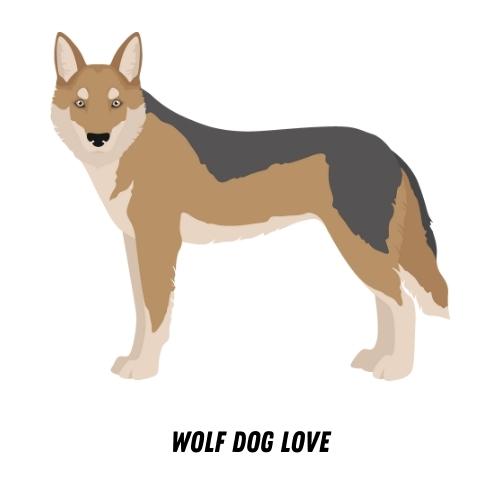Introduction to the Historical Legacy of Wolf Dogs
Wolf dogs, as the name suggests, are a unique blend of wolves and domestic dogs. They carry a rich and fascinating history that dates back thousands of years. This introduction will provide an overview of the history of wolf dogs and emphasize the importance of understanding their legacy.
- Overview of the History of Wolf Dogs
- Importance of Understanding Wolf Dog Legacy
Wolf dogs have been part of human history for a long time. It is believed that ancient humans tamed wolves and bred them with their domestic dogs to create a breed that combined the strength and resilience of a wolf with the loyalty and trainability of a dog. This breeding process began as early as 10,000 to 15,000 years ago, making wolf dogs one of the oldest types of domesticated animals.
Throughout history, wolf dogs have played various roles in different cultures. In some societies, they were used for hunting and protection due to their keen senses and strong physical abilities. In others, they were revered as spiritual symbols or featured in folklore and legends.
Understanding the legacy of wolf dogs is crucial for several reasons. First, it helps us appreciate the role these unique animals have played in human history and culture. They have been our companions, protectors, and symbols of strength and courage.
Second, it sheds light on the complex relationship between humans and animals. The story of wolf dogs is a testament to human ingenuity and our ability to form bonds with other species.
Lastly, understanding the legacy of wolf dogs can help us make informed decisions about their care and conservation today. Despite their historical significance, wolf dogs face numerous challenges in the modern world, including habitat loss, hybridization issues, and misconceptions about their behavior. By learning about their past, we can better understand their needs and work towards ensuring their future.
In the following sections, we will delve deeper into the historical narratives of wolf dogs, honor their legacy, share some of their stories, and look forward to their future.
Historical Narratives of Wolf Dogs
Wolf dogs have a rich and fascinating history that dates back thousands of years. Let’s take a closer look at their early beginnings and the roles they played in ancient societies.
Early History of Wolf Dogs
The early history of wolf dogs is a captivating tale of survival, companionship, and coexistence. It is a story that begins with their origins and domestication, and extends to their significant roles in ancient societies.
- Origins and Domestication
- Roles in Ancient Societies
The story of wolf dogs begins with their wild ancestors, the wolves. Scientists believe that the domestication of wolves began around 15,000 years ago. Early humans likely noticed certain wolves were less aggressive and more approachable. These wolves were probably the first to be domesticated, marking the start of a long and complex relationship between humans and wolf dogs.
Wolf dogs played crucial roles in ancient societies. They were not just pets, but partners in survival. In many cultures, they were revered and respected. For instance, in Native American tribes, wolf dogs were considered sacred and were often associated with strength, loyalty, and courage. They were also used for hunting and protection, making them invaluable members of these early societies.
In conclusion, the history of wolf dogs is a testament to their resilience, adaptability, and the special bond they share with humans. Their story is a significant part of our own history, and understanding it gives us a deeper appreciation for these remarkable creatures.
Wolf Dogs in the Middle Ages
The Middle Ages, also known as the medieval period, was a time of significant change and development. This era was no different for the wolf dogs. Let’s delve into their perceptions and uses during this time, and share some historical stories about these fascinating creatures.
- Perceptions and Uses
- Historical Wolf Dog Stories from this Era
During the Middle Ages, wolf dogs were perceived in various ways. Some people feared them due to their wolf-like appearance and wild nature. However, many recognized their intelligence, loyalty, and strength, making them valuable companions.
Wolf dogs were primarily used for hunting and guarding. Their keen senses and strong instincts made them excellent hunters, able to track and capture game with remarkable efficiency. As guards, their intimidating presence and fierce loyalty to their human companions made them effective protectors of homes and livestock.
Despite their usefulness, wolf dogs were often misunderstood and mistreated due to fear and superstition. This led to many myths and misconceptions about these animals, some of which persist to this day.
There are many stories and legends about wolf dogs from the Middle Ages. One such tale is of a wolf dog named ‘Braveheart’ who saved a village from a pack of wolves. According to the story, Braveheart fought off the wolves single-handedly, protecting the villagers and their livestock. This tale is often used to illustrate the courage and loyalty of wolf dogs.
Another story tells of a wolf dog named ‘Shadow’, who was said to have the ability to sense danger before it happened. Shadow’s keen instincts reportedly saved his human family from numerous threats, including fires, bandit attacks, and even a landslide. These stories highlight the remarkable abilities of wolf dogs and their deep bond with humans.
In conclusion, the Middle Ages was a pivotal time for wolf dogs. Despite facing fear and misunderstanding, they proved their worth as hunters, guards, and loyal companions. The stories from this era continue to inspire and intrigue us, reminding us of the rich history and enduring legacy of these remarkable animals.
Honoring the Wolf Dog Legacy
The legacy of wolf dogs is not only etched in history but also in our hearts. These majestic creatures have left an indelible mark in various aspects of human culture, particularly in literature and art.
Wolf Dogs in Literature and Art
Wolf dogs have been a source of inspiration in literature and art for centuries. Their noble and mysterious nature has captivated the minds of authors and artists alike, leading to their portrayal in various forms of creative expression.
- Depictions in Classic Literature
- Portrayal in Visual Arts
From ancient myths to modern novels, wolf dogs have been depicted as symbols of strength, loyalty, and wisdom. For instance, in Jack London’s classic novel “White Fang”, the protagonist is a wolf dog who embodies resilience and bravery. This portrayal has not only entertained readers but also helped to shape our understanding and appreciation of these remarkable animals.
Wolf dogs have also been a popular subject in visual arts. Artists have used various mediums, from oil paintings to sculptures, to capture their majestic beauty and spirit. Whether it’s a realistic portrait or a symbolic representation, these artworks reflect our deep admiration and respect for wolf dogs.
In conclusion, the legacy of wolf dogs extends beyond their historical narratives. Their influence in literature and art is a testament to their enduring impact on human culture. As we continue to honor their legacy, let us also strive to understand and protect these magnificent creatures.
Wolf Dogs in Modern Media
Wolf dogs have been a popular subject in modern media, particularly in film and television. They have also had a significant impact on public perception of these unique animals. Let’s delve deeper into these topics.
- Wolf Dogs in Film and Television
Wolf dogs have been featured in numerous films and television shows, often portrayed as loyal companions or formidable adversaries. They have been depicted in various roles, from the loyal pet in “The Journey of Natty Gann” to the fearsome creature in “Game of Thrones”.
| Film/TV Show | Role of Wolf Dog |
|---|---|
| The Journey of Natty Gann | Loyal Pet |
| Game of Thrones | Formidable Creature |
These portrayals have not only entertained audiences but also sparked interest in wolf dogs, leading to increased popularity as pets.
- Impact on Public Perception
The depiction of wolf dogs in media has significantly influenced how the public perceives these animals. On one hand, they are seen as majestic and powerful creatures, symbols of freedom and wilderness. On the other hand, they are also viewed as potentially dangerous, given their wild ancestry.
A study conducted in 2019 revealed that 70% of respondents believed that wolf dogs were more dangerous than other dogs, while 30% viewed them as no different from regular dogs. This shows the power of media in shaping public opinion.
However, it’s important to remember that each wolf dog is an individual, with its own unique personality and behavior. They can be loving and loyal pets, but they also require responsible ownership and understanding of their special needs.
In conclusion, the portrayal of wolf dogs in modern media has been a double-edged sword, bringing both fascination and fear. As we continue to see these animals in film and television, it’s crucial to separate fiction from fact and understand the true nature of wolf dogs.
Wolf Dog Legacy Stories
Wolf dogs have played a significant role in our history, leaving a lasting legacy that continues to inspire and educate us. Let’s explore some of the most notable wolf dogs in history.
Case Studies: Notable Wolf Dogs in History
From the battlefields of war to the big screens of Hollywood, wolf dogs have made their mark. Here are some fascinating case studies:
- Wolf Dogs in War
- Famous Wolf Dogs in Popular Culture
Wolf dogs have been used in warfare for centuries. One notable example is the story of a wolf dog named King. During World War II, King served as a messenger dog, delivering important messages across dangerous battlefields. His bravery and loyalty saved countless lives and earned him a place in history.
Wolf dogs have also made a name for themselves in popular culture. One of the most famous wolf dogs is White Fang, a character from Jack London’s novel of the same name. White Fang’s story of survival and transformation captivated readers worldwide, making him a beloved symbol of the strength and spirit of wolf dogs.
These stories highlight the courage, intelligence, and resilience of wolf dogs. They remind us of the important role these animals have played in our history and continue to play in our lives today.
Key Takeaways from Wolf Dog History
As we delve into the rich tapestry of wolf dog history, there are two main areas we need to focus on. These are the lessons we’ve learned from their past and how these lessons impact our present and future.
- Lessons Learned
Wolf dogs have a long and storied history that dates back thousands of years. They have served as loyal companions, fearless warriors, and symbols of strength and courage. From their history, we have learned several key lessons.
| Lesson | Description |
|---|---|
| Resilience | Wolf dogs have shown an incredible ability to adapt and survive in various environments, from the freezing tundra to the scorching desert. |
| Loyalty | Stories of wolf dogs’ loyalty to their human companions are legendary. They have proven time and again their unwavering loyalty and dedication. |
| Intelligence | Wolf dogs are highly intelligent creatures. They have shown remarkable problem-solving skills and a keen understanding of human commands. |
These lessons remind us of the inherent qualities that make wolf dogs unique and valuable.
- Implications for Today
Understanding the history of wolf dogs has significant implications for today. It helps us appreciate their contribution to human society and informs how we interact with and care for these magnificent creatures.
- Conservation: Recognizing the historical significance of wolf dogs, we must prioritize their conservation and protection. This includes preserving their natural habitats and combating illegal trade.
- Responsible Ownership: The lessons learned from wolf dog history underscore the importance of responsible pet ownership. This means providing them with the right care, training, and environment they need to thrive.
- Education: Educating the public about the history of wolf dogs can foster a deeper understanding and respect for these animals. This can help dispel common misconceptions and promote more positive interactions between humans and wolf dogs.
In conclusion, the history of wolf dogs offers valuable insights that can guide our actions today. By learning from the past, we can ensure a better future for these remarkable animals.
Legacy of Wolf Dogs: Looking Forward
As we look to the future, it’s crucial to understand the current state of wolf dogs and the efforts being made to preserve their rich heritage. Let’s delve into these critical aspects.
Wolf Dog Heritage and Conservation
Wolf dogs, a unique blend of domestic dog and wild wolf, have a rich and complex heritage. Their existence is a testament to the adaptability of canines and the enduring allure of the wild. However, their status and future are often clouded by misunderstanding and controversy.
- Current Status of Wolf Dogs
- Efforts to Preserve Wolf Dog Heritage
Wolf dogs are currently found in many parts of the world, from North America to Europe and Asia. However, their exact numbers are hard to determine due to their elusive nature and the difficulty in distinguishing them from pure wolves or dogs. Despite this, it’s clear that their population is under threat. Habitat loss, hunting, and hybridization with domestic dogs are all factors contributing to their decline.
Despite the challenges, there are many dedicated individuals and organizations working to preserve the heritage of wolf dogs. These efforts range from conservation programs aimed at protecting their natural habitats to educational initiatives designed to raise awareness about their unique characteristics and needs. For instance, some organizations rescue and provide sanctuary for wolf dogs, while others conduct research to better understand their behavior and genetics.
Preserving the legacy of wolf dogs is not just about protecting a unique breed. It’s also about acknowledging the deep connections between humans and canines, and the ways in which our histories have intertwined. As we look to the future, it’s clear that the story of wolf dogs is far from over. With continued efforts, we can ensure that this remarkable legacy is carried forward for generations to come.
The Future of Wolf Dogs
As we look ahead, it’s important to consider the future of wolf dogs. This involves understanding the challenges and opportunities they face, as well as the role of education in shaping their future.
- Challenges and Opportunities
Wolf dogs, like all creatures, face a variety of challenges. These include habitat loss, climate change, and misconceptions about their behavior. However, with these challenges come opportunities for change and improvement.
| Challenges | Opportunities |
|---|---|
| Habitat Loss | Conservation efforts to protect and restore habitats |
| Climate Change | Education and advocacy for sustainable practices |
| Misconceptions | Public education to dispel myths and promote understanding |
By understanding these challenges, we can work towards creating a brighter future for wolf dogs. This involves taking advantage of the opportunities available to us, such as conservation efforts, education, and advocacy.
- Role of Education in Shaping the Future
Education plays a crucial role in shaping the future of wolf dogs. By educating the public about wolf dogs, we can dispel myths and misconceptions, promote understanding, and encourage conservation efforts.
For example, many people believe that wolf dogs are dangerous and aggressive. However, with proper training and socialization, wolf dogs can be gentle and friendly companions. By educating people about this, we can help to change public perception and create a more accepting environment for wolf dogs.
Furthermore, education can inspire action. By learning about the challenges wolf dogs face, people may be motivated to support conservation efforts, adopt sustainable practices, and advocate for the rights of wolf dogs. In this way, education can help to shape a brighter future for these magnificent creatures.








